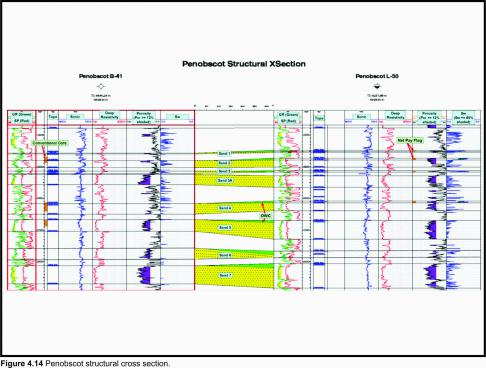Petrophysical assessments were conducted on the two Penobscot wells.
Penobscot – Formation Evaluation
A complete suite of the primary logging measurements were acquired in both Penobscot L-30 and Penobscot B-41. Two conventional cores were cut in L-30; however, both cores were cut well below the reservoir interval. In B-41 four conventional cores were cut within the Penobscot reservoir interval (Table 4.1).
|
Core# |
Interval (m MD) |
Recovery |
|---|---|---|
|
1 |
2499.4 – 2517.6m |
17.4m |
|
2 |
2642.6 – 2660.9m |
14.3m |
|
3 |
2660.9 – 2670.0m |
8.2m |
|
4 |
2699.0 – 2717.9m |
3.05m |
Table 4.1 Penobscot B-41 conventional cores.
Routine core analysis was conducted on the 4 cores. Average core porosity of the reservoir interval is 20%, with a maximum of 32%. Average permeability of the reservoir interval is 120 mD (arithmetic average) with a maximum of over 1000 mD.
No Drill Stem Tests (DSTs) were conducted in either Penobscot L-30 or B-41; however, a number of Repeat Formation Tests (RFTs) were run in the L-30 reservoir sands (Table 4.2).
|
Penobscot L-30 – Fluids Recovered from RFT (Sands 1 - 5 Only) |
|||||
|---|---|---|---|---|---|
|
Sand # |
Depth (m) |
Oil/Condensate (cc) |
Gas (cu ft) |
Water (cc) |
Remarks |
|
1 |
2480.2 |
3400 cc cond. |
1.0 |
nil |
|
|
2 |
2504.8 |
900 cc oil |
Nil |
8,000 |
|
|
2 |
2509.4 |
nil |
Nil |
10,250 |
Sample taken below |
|
2 |
2509.4 |
nil |
Nil |
3,750 |
Sample taken below |
|
3 |
2545.4 |
100 cc oil |
0.5 |
10,000 |
<1 m above OWC1 |
|
4 |
2639.3 |
3,800 cc cond. |
10.0 |
5,2002 |
|
|
4 |
2639.3 |
3,000 cc cond. |
5.0 |
Nil |
|
|
5 |
2700.5 |
nil |
Nil |
10,250 |
Transition zone3 |
|
5 |
2700.5 |
nil |
Nil |
3,750 |
Transition zone3 |
|
5 |
2700.8 |
nil |
Nil |
9,700 |
Transition zone3 |
1. Recovered mainly water due to proximity of OWC, i.e. RFT taken <1 m above OWC.
2. Both RFTs run at this depth recovered considerable condensate and gas. The water recovered from this RFT is likely mud filtrate and not formation water.
3. These RFTs were taken only 2 m above the interpreted OWC in sand 5. The upper portion of sand 5, at the L-30 location, is within the transition zone and has a high water saturation (Sw ~70%) resulting in water recovery on RFT.
Table 4.2 Penobscot L-30 RFT results.
Seven normally pressured hydrocarbon bearing sands were encountered in Penobscot L-30 within the middle Missisauga Formation. The RFT fluid recoveries indicate that most sands appear to contain light oil/condensate and gas. It is unclear if the gas is solution gas or free gas. Based on a petrophysical assessment using available log, core and RFT data (Table 4.3), it appears that light oil/condensate is the primary reservoir fluid. Each L-30 sand was interpreted to have a separate log defined oil-water contact (Figure 4.14).
|
Penobscot L-30 – Reservoir Properties |
|||||
|---|---|---|---|---|---|
|
Sand |
Top (m MD) |
Base (m MD) |
Net Pay (m TVD) |
Net Pay Por. (%) |
Sw (%) |
|
1 |
2477.6 |
2484.9 |
1.2 |
19 |
49 |
|
2 |
2503.0 |
2530.9 |
4.6 |
21 |
46 |
|
3 |
2542.0 |
2546.6 |
2.1 |
18 |
41 |
|
3A |
2558.5 |
2594.6 |
Wet |
N/A |
N/A |
|
4 |
2638.0 |
2669.0 |
4.3 |
19 |
45 |
|
5* |
2699.2 |
2758.5 |
01 |
N/A |
N/A |
|
6* |
2795.5 |
2805.4 |
01 |
N/A |
N/A |
|
7* |
2835.3 |
2912.8 |
01 |
N/A |
N/A |
* Penobscot L-30 was drilled on the flank of the South Penobscot structure and thus encountered relatively thin oil columns at the L-30 location. There is approximately 15 m of additional structural relief, for each of the Penobscot sands, updip of L-30. Sands 5 -7 have interpreted oil-water contacts within a few metres of the top of each sand. As a result, the top portion of these sands is transitional and has high water saturation (~70%). Sands 5 – 7 appear to have very thin (<0.5 m) oil pay over water at the very top of the each sand which supports the interpretation that the sands are transitional at the L-30 location.
Table 4.3 Penobscot L-30 Reservoir Properties.


